Music is the universal language
“Glory to God in the highest heaven, and on earth peace to those on whom his favor rests.” - Luke 2:14
Norse Guitar Feeds
Letter from the Managing Editor | Happy Camper
Wilco’s Jeff Tweedy teams up with Martin on two signature acoustics – the all-new, fun-sized 000 Jr E and the returning 00DB

Martin has teamed up with Wilco frontman Jeff Tweedy on two new signature acoustic models, the reissued 00DB Jeff Tweedy and the all-new 000 Jr E Jeff Tweedy
Both guitars bring Tweedy’s preferred features to players — from deep, resonant bodies and long-scale necks to FSC-certified tonewoods and the signature Tweedy Burst finish.
The 00DB Jeff Tweedy, first introduced in 2012, makes its return with the same “warm, balanced voice” that made it a fan favourite, alongside modern refinements like a certified ebony fingerboard and bridge. Crafted from FSC-certified solid mahogany with scalloped European spruce X-bracing, the model retains its deep 00 body design, long 25.4” scale, and signature Tweedy Burst finish. The guitar also comes detailed with faux tortoise binding and Foden-style inlays.
“The thing I love about my guitar, the deep-body element of it, is that it has a warmth for a smaller body guitar,” says Tweedy. “It’s somewhere between a Dreadnought and an 0-style guitar.”
Joining it is the 000 Jr E Jeff Tweedy, a new, more compact signature designed to bring Tweedy’s tone and feel to a broader range of players. Crafted from FSC-certified sapele with the same satin Tweedy Burst finish, it features a 000 Junior body, full 24.9” scale length, Martin E1 electronics with a built-in tuner, and a Performing Artist neck for greater playability.
“The idea that we could do this again, and then also offer a guitar that may be a little bit more affordable to people starting out, and maybe a little smaller for smaller hands starting out – that’s a thrill to me,” says the guitarist.
Both models trace their inspiration back to the vintage Martin 0-18 Tweedy purchased in the late 90s. It was that guitar that Tweedy used to write the celebrated Mermaid Avenue album with Billy Bragg, setting Woody Guthrie’s then-unheard lyrics to music. That instrument, he says, “became basically part of my writing voice… it’s the main acoustic I’ve had my whole life.”
“Well-made guitars, like the Martin guitars that you make, inspire creativity because they don’t present an obstacle to creativity,” Tweedy adds. “Someone buys a guitar with my name on it and takes it home – I hope it becomes a part of their daily habit of making some music.”
Priced at $3,599 and $1,149 respectively, the 00DB Jeff Tweedy and 000 Jr E Jeff Tweedy are now available through authorised Martin dealers worldwide and on Martin’s website.
Learn more at Martin Guitars.
The post Wilco’s Jeff Tweedy teams up with Martin on two signature acoustics – the all-new, fun-sized 000 Jr E and the returning 00DB appeared first on Guitar.com | All Things Guitar.
Warm Audio unveils the Tube Squealer and Throne of Tone – two pedals that capture the soul of legendary overdrives

Warm Audio has unveiled the Throne of Tone and Tube Squealer, two new pedals that pay homage to some of the most iconic overdrive circuits in guitar history.
True to the brand’s reputation, both pedals promise faithful analogue recreations built with premium components, while adding smart, modern touches for today’s players.
“These are two of the most popular styles of overdrive in guitar history, and we’re excited to add them to the Warm lineup,” says Warm Audio founder and president Bryce Young. “We maintained the Warm formula of vintage-accurate tone and premium components, but we went a step further to combine some of the greatest iterations of these tones along with feature-rich functionality into each.”
- READ MORE: Fender expands its Hammertone pedal line with two new offerings: the Breakup Drive and Boost
To start, we’ve got the Tube Squealer, Warm Audio’s spin on one of the most celebrated overdrives ever made — the Tube Screamer. Built with 100% analogue circuitry and loaded with modern, rig-ready features, the pedal offers three selectable voicings that each nail a different era of the original’s tone. 808 delivers the earliest iteration of the classic overdrive, the TS9 captures the most produced and widely recognised version, and the TS10 revives an underrated circuit that’s found new life with modern players.
Beyond the traditional controls, the Tube Squealer adds a Mix knob that lets players blend their clean signal back in with the overdrive, a pickup-voicing selector to optimise the pedal for single-coil or humbucker guitars, as well as an external voltage booster for expanded headroom.
Inside, it’s packed with high-quality JRC4558 op-amps, discrete transistors, diodes, premium JFETs, and asymmetrical clipping for that unmistakable smooth, tube-like breakup.
Next is the Throne of Tone, a dual-sided overdrive inspired by the Marshall Bluesbreaker and the boutique pedals that followed in its wake. Designed for ultimate flexibility, this pedal offers two classic voicings, each with low and high gain levels and three drive modes: boost, overdrive, and distortion.
According to Warm Audio, the Throne of Tone excels at British-style breakup thanks to a symmetrical clipping circuit that captures the feel of classic tube amps cranked beyond their clean limits.
Tone shaping is highly flexible too: each side of the Throne of Tone comes with an independent Presence control (adjustable from 500Hz to 2.3kHz) alongside the standard tone knob. There’s also a rear-panel send/return loop for inserting other pedals between the two sides, plus a voltage doubler that runs internally at 9V or 18V for extra headroom and definition. The pedal also features true-bypass switching.
Under the hood, 24 diodes and premium JRC4580 and TL072 op-amps power two fully analogue circuits, delivering uncompromising tone in a versatile, performance-ready package.
“For the Throne of Tone, we decided to honour the 3-knob vintage pedal that inspired a whole wave of boutique recreations, and added a second side plus alternative voicing to deliver the most unobtainable boutique blues OD,” Young explains. “With these unique voicing options, plus added features for presence, gain structure, and gain amount, you can create dozens of combinations previously unavailable in addition to getting the authentic sound of the originals – all in one stomp box!”
The Tube Squealer is priced at $149/€159/£139 (inc. VAT), and is available exclusively at Guitar Center in the US and authorised retailers worldwide. Meanwhile, the Throne of Tone retails for $229/€249/£219 (inc. VAT) and is available at all authorised Warm Audio retailers.
Learn more at Warm Audio.
The post Warm Audio unveils the Tube Squealer and Throne of Tone – two pedals that capture the soul of legendary overdrives appeared first on Guitar.com | All Things Guitar.
Wolfgang Van Halen admits he finds it “bittersweet” to play his father’s iconic Frankenstein guitar
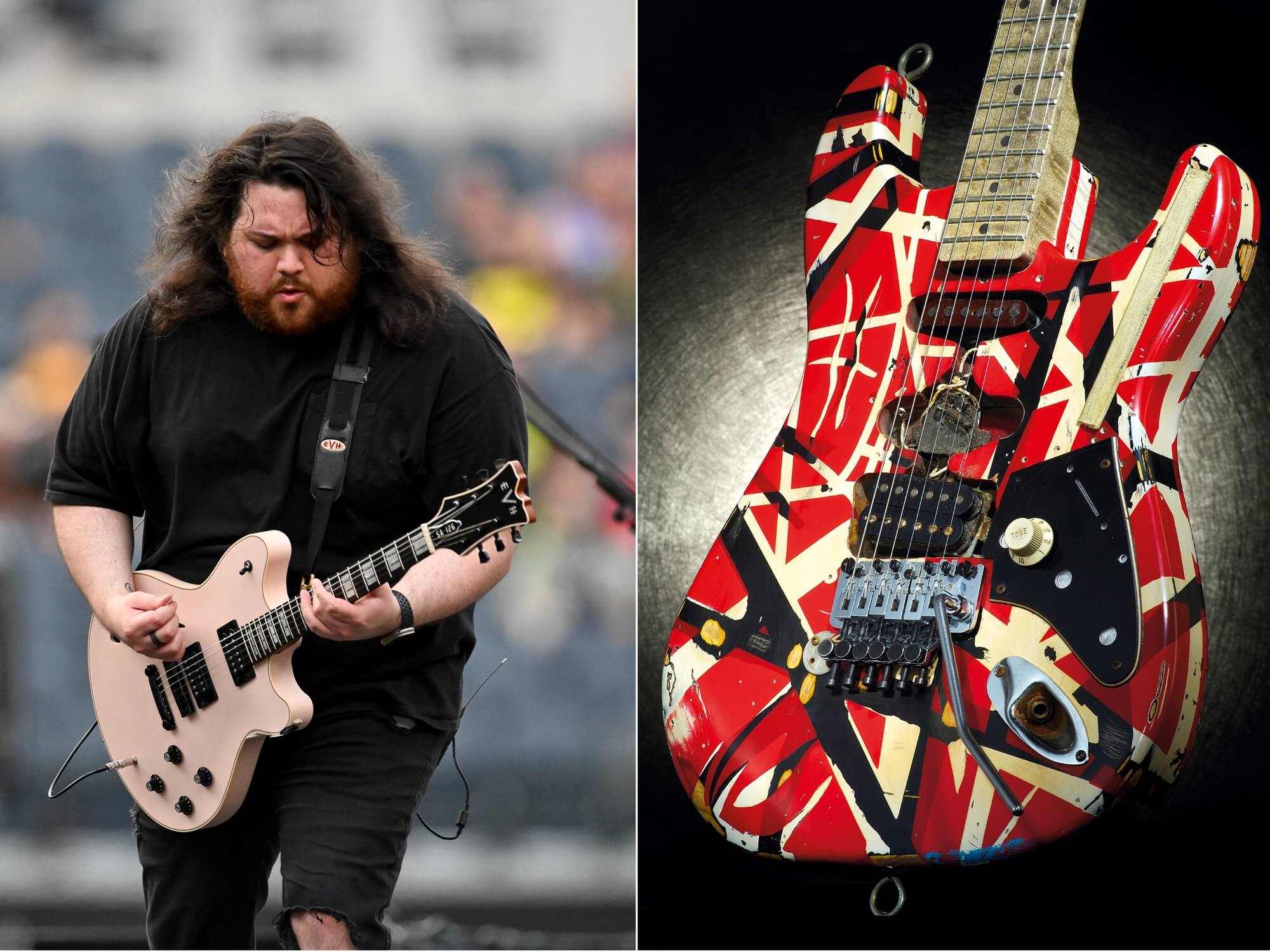
For Wolfgang Van Halen, few instruments carry more emotional weight than his father’s Frankenstein guitar – the iconic red-black-and-white Strat that rewrote the rules of rock.
Built and modded by Eddie Van Halen himself in the late ‘70s, Frankenstein is one of the most recognisable guitars in music history. And decades later, it’s still shaping the sound and story of Van Halen’s legacy, now through Wolfgang’s hands.
Speaking to Guitar World about Mammoth’s upcoming album The End, Wolfgang explains that every time he brings out the guitar, he feels the full gravity of what it represents.
“Any moment I have it in my hands… just being able to hold something that my dad had such a history with is nice, since my dad’s not around anymore,” says Wolfgang. “It’s a little bittersweet, but it’s a nice thing to have on the record with me. I think that’s why I try to bring it out on every record.”
Recording at the famed 5150 studio, he adds, only amplifies that feeling.
“I mean, just the fact I’m recording in 5150 is enough,” says the guitarist. “But because Frankenstein is arguably one of the most famous instruments in music history, let alone guitars… the emotional and historical weight of it all is a lot to handle. You almost have to push it to the side and just enjoy the moment.”
While the Frankenstein makes its presence felt across The End, Wolfgang says the backbone of the album comes from his own signature EVH SA-126 – a guitar he developed alongside Matt Bruck, Eddie’s longtime guitar tech, and EVH masterbuilder Chip Ellis.
“I have a burst – I believe it was the second prototype of the 126 – and that was the backbone of Mammoth II,” he says. “Pretty much everything recorded on The End was the goldtop 126 I have now, other than the Frankenstein guitar parts. It’s just been so fun to have this instrument that Matt Bruck, Chip Ellis and I put together become the defining sound of what Mammoth has become.”
Amp-wise, he’s kept things simple, sticking to what he knows best. “It’s pretty straightforward, and it’s what we’ve been using on tour,” Wolfgang notes. “I have the EVH 5150 III 6L6, and the specific one I have in the studio is the one I used for the Taylor Hawkins tribute shows [in 2022]. The cabinet, too.”
The post Wolfgang Van Halen admits he finds it “bittersweet” to play his father’s iconic Frankenstein guitar appeared first on Guitar.com | All Things Guitar.
Fender Mark Speer Stratocaster review: “a 70s Strat that everyone can enjoy?”

$1,499/£1,399, fender.com
Part of the extraordinary success and enduring appeal of the Fender Stratocaster is its malleability. Perhaps more than any other golden era electric guitar design, the Strat’s basic recipe has a receptiveness to tinkering and evolution that has enabled it to be used in every genre imaginable.
I’ve owned quite a few off-the-shelf Strats myself over the years, and there hasn’t been one that I haven’t tweaked in some way – whether that involves changing the pickups, swapping the bridge, or upgrading the tuners.
All this means that we’re often quite inured to leftfield Strat variants – a Strat is a Strat, right? And yet, this latest Fender signature guitar for Khruangbin guitarist Mark Speer is a very different flavour of Strat to the norm – indeed, it’s one of the most personalised Strats Fender has put out in a while.
 Image: Adam Gasson
Image: Adam Gasson
Fender Mark Speer Stratocaster – what is it?
This signature model (which arrives alongside a signature bass from bandmate Laura Lee) is heavily modelled on the Strat that Speer has used almost exclusively in his time with Khruangbin – which has been tweaked and modded extensively over that time.
The original guitar is a 2001 Fender Classic Series ’70s Stratocaster, and the spec sheet pulls in a lot of the biggest hits from that much-maligned original era of guitars. So you’ve got the vintage fretboard radius, you’ve got the big 70s headstock, a natural finish and in this case it even comes fitted with flatwound strings.
You probably have your opinions on all of that – I certainly do. As someone who prefers his Strats to have none of the above, you might even describe this as my own personal Fender nightmare, but there is one notorious design feature here that I will forgive it all for.
The Micro-Tilt neck with its three-bolt assembly is often held up as an example of everything wrong with the CBS era, but many of the changes implemented to the core design in this period actually came from Leo Fender himself, who stuck around in a consultancy role for a while before moving on to Music Man in 1979.
The Micro-Tilt is one such innovation; allowing you to tweak the angle of the guitar’s neck in relation to the instrument body via a small hex key hole in the neck plate. It enables extra control over fine-tuning the guitar’s setup as a result. This innovation also led to the introduction of the bullet truss rod and the moving of the adjustment to the top of the neck instead of the bottom. Both of these are genuinely good things for the playability and ease of maintenance of a Strat, no matter what vintage guitar aficionados tell you.
That’s all present and correct on the Speer Strat, and so it’s a big tick from me in that regard, but from there things get a bit more freaky. You’ll notice, for example, the presence of white Graph Tech saddles, which are designed to improve tuning stability by reducing friction on the break angle. These may be a visually jarring appointment but are borne of real-world experience.
 Image: Adam Gasson
Image: Adam Gasson
“A lot of those adjustments were made from a pragmatic standpoint,” Mark explains. “The Graph Tech saddles were there because I just don’t want strings to break that often. When you’re a struggling working musician, buying strings all the time is not something you like doing.” Fair point.
The graphite additions extend to not one, but two string trees, which not only provide the steeper break angle over the nut but, in the case of the G string, prevents that pesky harmonic that sometimes rings out when not required.
Other breaks from the norm include a pair of DiMarzio Pro Track single-coil-sized rail humbuckers in the bridge and neck. These were chosen mainly because Mark dislikes the hum from single coils – but you can certainly hear their strident tones in Khruangbin’s music.
The original 2001 guitar had an ash body, and so it is here – that in itself is notable because it’s quite rare to see on a production Fender guitar in 2025, with a few Player II chambered Strat and Tele variations proving welcome exceptions on the affordable front. Sadly, the devastating toll that various pests have had on the global ash tree population has made what was once a hugely prevalent wood harder to find, and so the brand began phasing out ash-bodied production guitars in 2020. Clearly, they are back on the scene, though in select model runs. And the transparent nature of the original guitar’s finish meant that ash was the only choice to replicate it properly.
 Image: Adam Gasson
Image: Adam Gasson
Fender Mark Speer Stratocaster – build and playability
I must admit, the mere sight of an ash body causes my back to spasm, such has been the weight of ash-bodied guitars I’ve owned in the past. However, clearly I’ve just been choosing my guitars unwisely, as pulling the Speer out of its suitably 70s brown-tolex hard case reveals it to be not just light – but 7lbs light. Highly unusual for a Strat in 2025.
I must admit I’ve never loved the natural finish on guitars of this era – they just look thick and sticky, and a bad reminder of when Fender switched to polyurethane finishes. Again, to give it a thin nitro sheen would be deviating from the original guitar, and Speer clearly feels that it’s served him well thus far.
The neck carve has been created in conjunction with Speer and it’s best described as a typical modern ‘C’ shape and very comfortable. The jumbo fretwork is nicely done, and the height gives me some reassurance that the vintage 7.25” radius won’t be too impactful upon playability and the ability to bend.
All in all, it feels a solid, well put together guitar – the sort of thing you’ve come to expect from Fender’s Ensenada-made signature models in recent years.
 Image: Adam Gasson
Image: Adam Gasson
Fender Mark Speer Stratocaster – sounds
Plugged into my Fender ’64 Deluxe Reverb with the reverb in full effect, emulating Speer’s tone is a cinch. The Dimarzio Protrack bridge pickup is based on a vintage PAF and unsurprisingly doesn’t provide typical single-coil chime, but it sounds quite warm whilst not unpleasantly driving the amp in the manner we expect from rail-style pickups.
My chordal work still has an underlying twang, which isn’t often prominent in bridge humbuckers, and we are thankfully bereft of the often-scathing brightness of a single coil in the bridge position.
Iconic Strat sounds are actually found in position three (middle pickup) via a Fender single coil ‘vintage voiced 70s’ pickup. I find myself spending quite a lot of time here, as it’s a lot fuller-sounding than most middle pickups, and possesses a warmth I wouldn’t normally associate with a middle pickup.
Position two (bridge and middle pickups in phase) provides plenty of quack, and impressively, the volume doesn’t dip dramatically, as can often be the case. The same can’t be said for position four, which is wired with the middle and neck pickups out of phase. The thin hollow tone has its appeal with many famous players but the volume drop is dramatic and the amp’s volume control needs increasing somewhat to compensate.
A signature guitar can’t just be about emulating the sound of its creator, however – the best ones can work in a variety of settings. With that in mind, I load up my Mesa/Boogie Mark IV and dial in a strident lead tone.
I genuinely expected the flatwound strings to sound dull and lifeless with a higher gain setting, but pleasingly this isn’t the case at all. Heavy riffs are still heavy and switching to the neck pickup gives us some wonderful creamy vintage rock tones. What emerges is a versatile and interesting guitar with plenty of sonic real estate to occupy beyond the world of Texan-fried psychedelica.
 Image: Adam Gasson
Image: Adam Gasson
Fender Mark Speer Stratocaster – should I buy one?
On paper, the Speer Strat is everything I don’t really want in a Strat – the vintage specs, the 70s looks, it’s everything that I tend to struggle with. And yet in practice this is a guitar with a huge palette of onboard sounds contained within that five-way selector. It’s a guitar that can provide a workable tone for practically any genre thrown at it.
Even as someone who spends most of his time at the shreddier end of the guitar pool, I found the playability surprisingly great too. I was expecting the vintage radius and slinky action to lead to choking out bends, but those tall frets make it a much more accommodating experience.
Speer is an unusual and pretty unique guitar player in the modern era, and this is a guitar that befits that traditional-meets-eclectic vibe that he has brought to Khruangbin. A 70s Strat that everyone can enjoy? Try one and tell me I’m wrong…
Fender Mark Speer Stratocaster – alternatives
Another S-type guitar that offers a bunch of handy pro-ready fixes and evolutions is Yamaha’s reimagined Pacifica Standard Plus ($1,349/£1,249). Another S-type guitar with rail-type humbuckers is PRS’s hugely impressive SE NF3 ($799/£799) – it’s one of the finest sub-$1,000 guitars around. Fender also offers a modded take on the Strat in its own line-up, of course, and the Player II Modified HSS Strat ($1,079.99/£999) is a very impressive example.
The post Fender Mark Speer Stratocaster review: “a 70s Strat that everyone can enjoy?” appeared first on Guitar.com | All Things Guitar.
Win Kurt Cobain's Guitar Pick
Stompboxtober 2025: Rock N Roll Relics

Pedal lovers, today’s your chance! Enter now to WIN the Stinger Overdrive from Rock N Roll Relics — vintage mojo meets modern feel, with NOS components and smooth gain control that can take you from soft grit to fiery leads. Don’t miss it — and be sure to stop back tomorrow for another killer giveaway!
Stompboxtober 2025 - Win Pedals All Month Long!
Stinger Overdrive
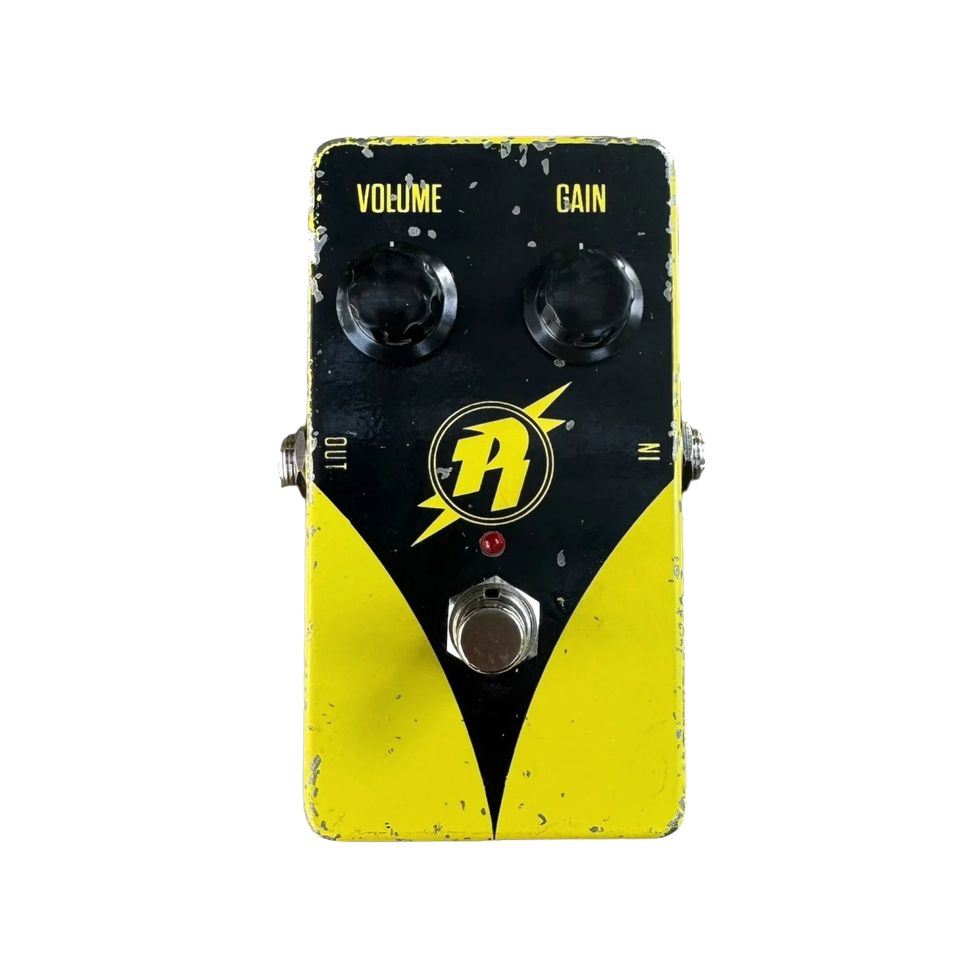
The Rock N Roll Relics Stinger overdrive has all the mojo of classic yellow drive pedals, but with tonal refinements to bring it to the modern age. We use NOS construction as you’ll come to expect with the Stinger Series, which gives it that authentic, ear-pleasing tone we all want. $289 Street
Revv Launches a MK2 Update of their Groundbreaking D20 Amplifier 6 Years in the Making
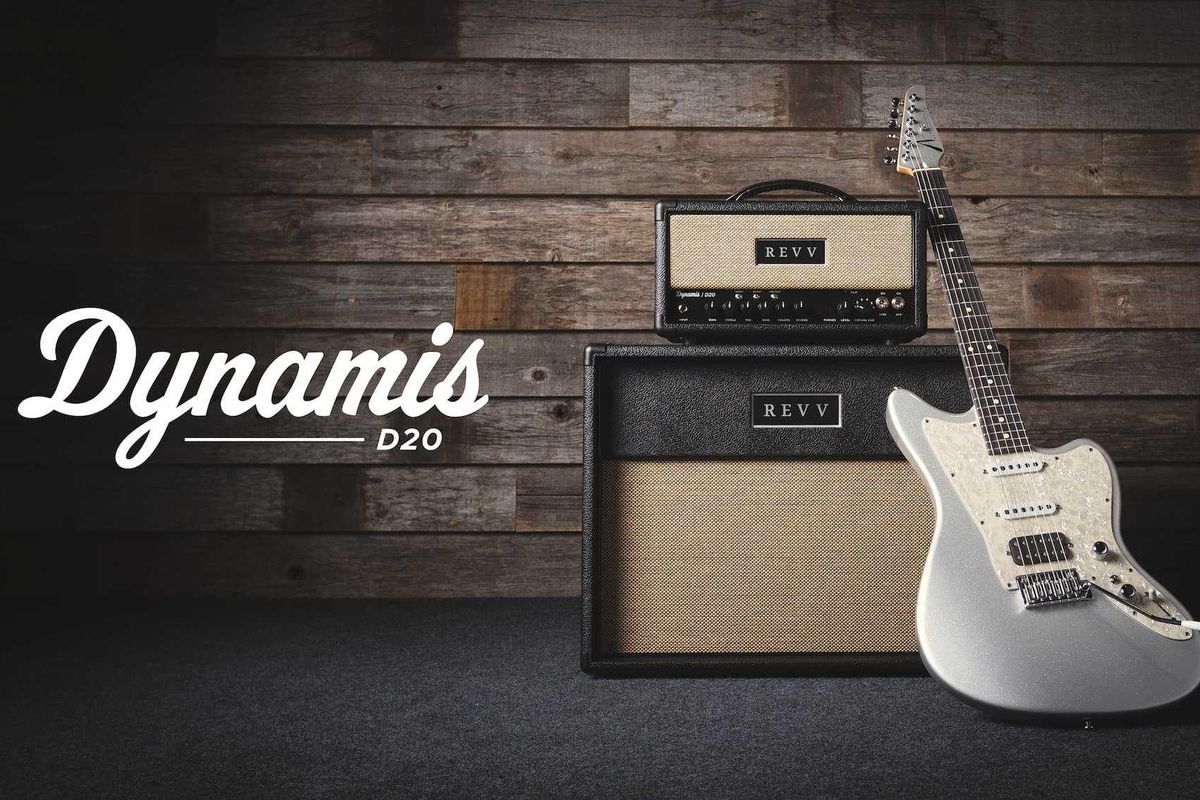
Revv Amplification set the standard for clean lunchbox amplifiers in 2019 with the release of the D20: a portable all-tube amplifier & the world’s first with Two notes Torpedo-embedded direct XLR for zero-compromise tone & feel without a cabinet. 6 years later, Revv saw fit to raise the standard with the D20 MK2, featuring a host of tonal and functional upgrades based on feedback from some of the most respected recording & touring guitarists in the world. Even better - Joey Landreth is once again lending his ears to a Joey Landreth D20JL, promising the same MK2 improvements with additional headroom & top end on tap (not to mention the exclusive JL colorway); similar to the fan-favorite D25JL released earlier this year. Both heads now come standard in a new tolex lunchbox enclosure for an ideal combination of looks & weight reduction. Complete with onboard reverb & an included 2-button footswitch, the D20 MK2 & D20JL are ideal for any player looking for a single-channel clean/edge-of-breakup amp with a touch-sensitive feel & record-ready tone.
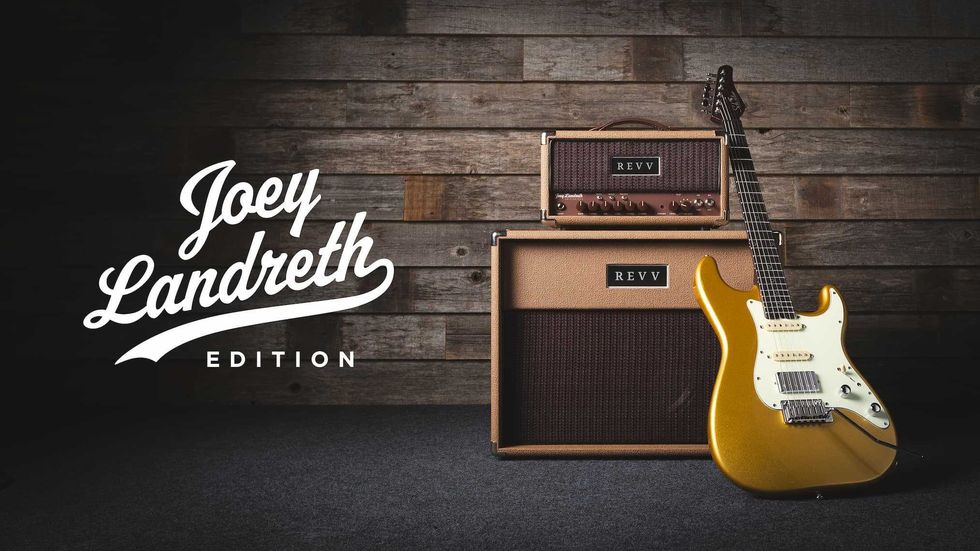
“These new D20s feel like a step towards the next generation of Revv. Getting to introduce these to the world all over again with 6 years of tone tweaks & workflow improvements is a dream come true & getting to work with Joey is always super fun. I really look forward to seeing what guitarists do with these.” - Dan Trudeau, President & Designer Revv Amplification Inc.
The D20 MK2 features:
- The award-winning D20 platform w/ new switching, reverb, & tonal updates 6 years in the making.
- All-tube design w/ 2x 12AX7 preamp + 2x 6V6 power tubes. Switchable from 20w to 4w operation.
- Gain, Treble, Middle, Bass, Volume, Reverb, & Level controls + Treble & Gain Boost switches.
- Perfect for clean & edge of breakup tones w/ an organic, touch-sensitive feel ideal for pedals.
- Pristine digital reverb, transparent buffered effects loop, MIDI control, & more.
- Two notes Torpedo-embedded reactive load & impulse response XLR out for direct performance & recording.
- Special Joey Landreth Edition D20JL features tone tweaks & exclusive aesthetics inspired by the D25JL.
- New standard tolex lunchbox design. 10” x 14.75” x 8.75” - 15.5lbs.
- Manufactured in Canada to rigorous quality standards w/ 2 year limited warranty & included 2-button footswitch.
The street price for Revv’s D20 MK2 is $1349US, & $1499 for the D20JL. Both can be ordered immediately through many fine dealers worldwide or directly at www.revvamplification.com.
Epiphone Launches Joe Bonamassa '59 Les Paul Custom
Epiphone is proud to continue its decades-long signature relationship with blues-rock legend Joe Bonamassa. Today, Epiphone has released an attainable version of Bonamassa’s pristine and rare, vintage 1959 Black Beauty Les Paul™ Custom, bringing this remarkable instrument—offering vintage tone, elegant craftsmanship, and the unmistakable spirit of Bonamassa in a guitar built to inspire—to a wider audience. The Epiphone Joe Bonamassa ’59 Les Paul Custom is a limited-edition model now available worldwide at authorized dealers, Gibson Garage locations, and on www.epiphone.com.
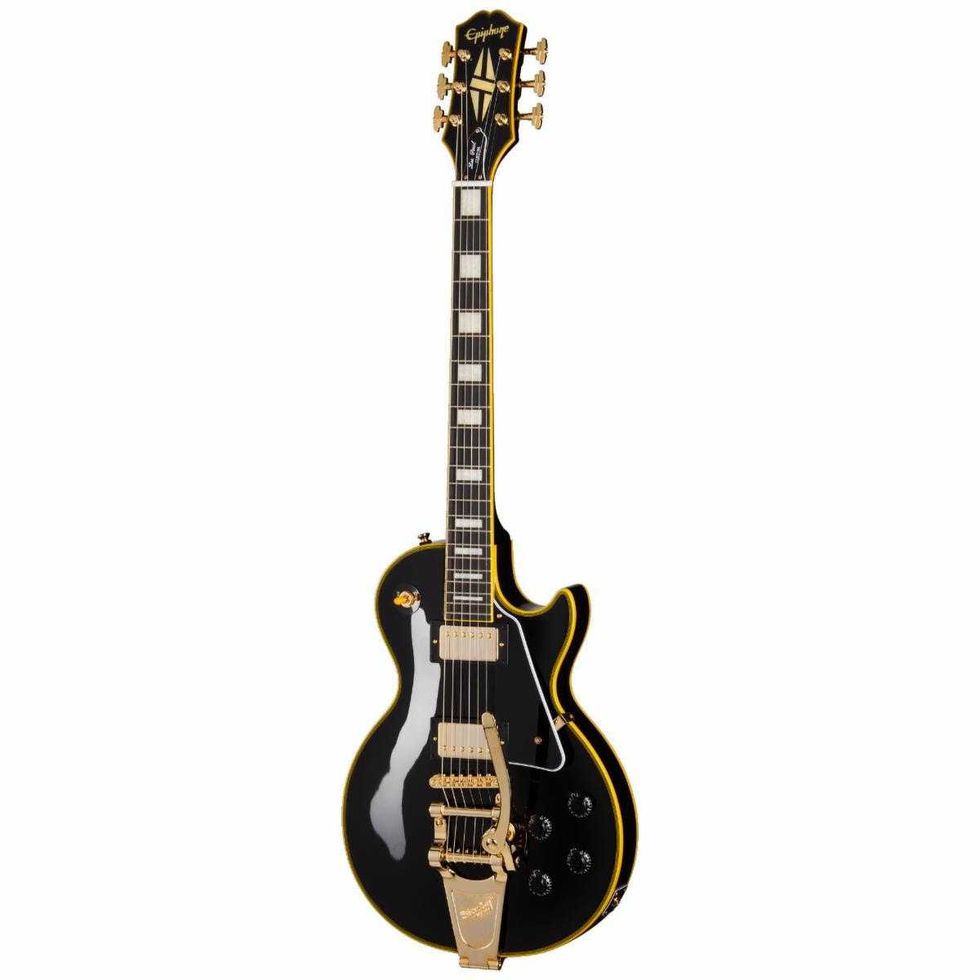
Joe Bonamassa is widely renowned for his guitar-playing prowess and as a world-class guitar collector. One prized gem in his collection is his 1959 Gibson Les Paul Custom. The original Les Paul Custom became known as the “Black Beauty,” and examples from the late 50s are highly sought after, but this particular guitar is quite unique. Joe’s guitar is a rare custom order with two pickups instead of the standard three-pickup configuration. Adding to its allure, it also sports Grover® Imperial™ tuners and a Bigsby® vibrato tailpiece.
Designed to be both faithful and accessible, the Epiphone Joe Bonamassa ’59 Les Paul Custom features an Antique Ebony finish over a solid mahogany body, accented by aged multi-ply binding on the top and back. The mahogany neck sports a 1959 Rounded Medium C profile and is topped with a bound ebony fretboard, complete with 22 medium jumbo frets and dressed up with pearloid block inlays. The multi-ply bound 60s Kalamazoo-style headstock features the Epiphone logo and the iconic Custom Split Diamond inlay in mother-of-pearl and is outfitted with a low-friction Graph Tech® nut for excellent tuning stability.
The Joe Bonamassa ’59 Les Paul Custom is powered by a pair of punchy-sounding Epiphone ProBucker™ Custom pickups, which are wired to individual volume and tone controls using high-quality CTS® potentiometers for outstanding tonal versatility and reliability. As is fitting for a Les Paul Custom, the hardware is gold, including a LockTone™ Tune-O-Matic™ bridge, the Grover tuners, and the Bigsby B70 vibrato tailpiece. The combination of these elements creates an instrument that is not only visually stunning but also remarkably versatile in its sound. The Epiphone Joe Bonamassa ’59 Les Paul Custom comes with a certificate of authenticity and a hardshell case with “Nerdville” graphics. This limited-edition Epiphone Joe Bonamassa ’59 Les Paul Custom is a tribute to a legendary guitarist and an iconic guitar. It represents both a lasting investment and excellence in musical instrument craftsmanship. This release will be available in a limited quantity of 1,000 exclusively through Epiphone, the Gibson Garage, and authorized Epiphone dealers. In addition, a limited run of 300, with an exclusive custom inlay on the fretboard, will be available via the Joe Bonamassa webstore.
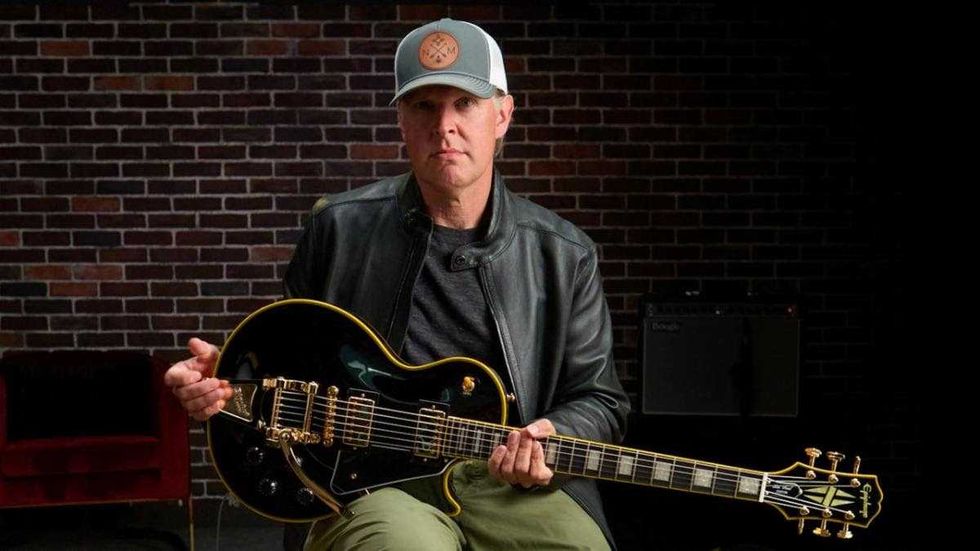
Blues-rock superstar Joe Bonamassa is one of the most celebrated performing musicians of today. As a 4X GRAMMY®-nominated artist and 15x Blues Music Award Nominee (4X winner), he recently notched his 29th No. 1 album on the Billboard Blues Chart with his latest studio release, Breakthrough, hailed as his most adventurous and genre-defying album to date. Live at the Hollywood Bowl With Orchestra became his 28th No. 1. Bonamassa has become a living legend with an astounding multi-genre catalog, releasing more than 50 albums, including studio and live recordings, as well as collaborative projects like Black Country Communion and Rock Candy Funk Party.
Recently, Bonamassa released Blues Summit 100 — a massive 32-track project featuring multiple artists paying tribute to B.B. King; listen HERE. Bonamassa returns to the road this fall and will continue through his spring 2026 tour, dates below and HERE.
Catch Joe Bonamassa on tour in the following cities:
U.S. FALL TOUR 2025
November 3 – Columbus, OH – Palace Theatre
November 5 – Toronto, ON – The Theatre at Great Canadian Toronto
November 7 – Detroit, MI – Fox Theatre
November 8 – Fort Wayne, IN – Embassy Theatre
November 10 – Rockford, IL – Coronado Theatre
November 11 – Kansas City, MO – The Midland Theatre
November 14 – Durant, OK – Choctaw Grand Theater
November 15 – Houston, TX – Hobby Center
November 18 – Corpus Christi, TX – American Bank Center Selena Auditorium
November 19 – Abilene, TX – Abilene Auditorium
November 21 – Midland, TX – Wagner Noël Performing Arts Center
November 22 – Austin, TX – ACL Live at The Moody Theater
November 23 – Shreveport, LA – Shreveport Municipal Auditorium
November 25 – Fayetteville, AR – Walton Arts Center
November 26 – St. Louis, MO – Stifel Theatre
November 29 – New Orleans, LA – Saenger Theatre
November 30 – Montgomery, AL – Montgomery Performing Arts Centre
December 2 – Savannah, GA – Johnny Mercer Theatre
December 3 – Sarasota, FL – Van Wezel Performing Arts Hall
December 5 – Estero, FL – Hertz Arena
December 6 – Hollywood, FL – Hard Rock Live
U.S. SPRING TOUR 2026
February 21 – South Bend, IN – The Morris Performing Arts Center
February 23 – Cedar Rapids, IA – Paramount Theatre
February 25 – Madison, WI – Overture Center for the Arts
February 27 – Peoria, IL – Prairie Home Alliance Theater
February 28 – Cincinnati, OH – Taft Theatre
March 2 – Wilkes-Barre, PA – F.M. Kirby Center for the Performing Arts
March 4 – Springfield, MA – Springfield Symphony Hall
March 6 – Westbury, NY – Flagstar at Westbury Music Fair
March 7 – Pittsburgh, PA – Benedum Center
March 8 – Red Bank, NJ – Count Basie Center for the Arts
March 10 – Reading, PA – Santander Performing Arts Center
March 11 – Virginia Beach, VA – Sandler Center
March 13 – Durham, NC – DPAC
March 14 – Greenville, SC – Bon Secours Wellness Arena
March 17 – Knoxville, TN – Knoxville Civic Auditorium
March 19 – Huntsville, AL – VBC Mark C. Smith Concert Hall
March 20 – Macon, GA – Atrium Health Amphitheater
March 21 – Clearwater, FL – The BayCare Sound
March 25-29, 2026 – Miami, FL – Keeping The Blues Alive at Sea XI +
April 10-12, 2026 - Miramar Beach, FL - Sound Wave Beach Weekend +
+Sold Out
EU TOUR 2026
April 22 - Hamburg, DE - Barclays Arena
April 24 - Rotterdam, NL - Rotterdam Rtm Stage
April 25 - Paris, FR - La Seine Musicale
April 27 - Esch-sur-Alzette, LU - Luxembourg Rockhal
April 29 - Mannheim, DE - SAP Arena
May 1 - Chemnitz, DE - Stadthalle Chemnitz
May 2 - Nürnberg, DE - Psd Bank Nürnberg Arena
May 3 - Zürich, CH - Hallenstadion
May 6 - London, UK - Royal Albert Hall
May 7 - London, UK - Royal Albert Hall
October 21 - Helsinki, FL - Veikkaus Arena
October 23 - Stockholm, SE - Stockholm Avicii Arena
October 24 - Oslo, NO - Oslo Spektrum
October 25 - Gothenburg, SE - Göteborg Partille Arena
October 27 - Copenhagen, DK - K.B. Hallen København
October 29 - Rostock, DE - Stadthalle Rostock
October 30 - Berlin, DE - Uber Arena
October 31 - Dortmund, DE - Westfalenhalle
November 4 - Milan, IT - Unipol Forum
November 6 - Toulouse, FR - Zénith Toulouse Métropole
November 7 - Barcelona, ES - Barcelona Sant Jordi Club
Vernon Reid Signature Guitar Giveaway From Reverend Guitars!

Win the stunning Reverend Vernon Reid Signature “Totem” Guitar—a bold fusion of art, tone, and attitude designed with Living Colour’s trailblazing guitarist. Featuring custom Jung- and Basquiat-inspired graphics, Railhammer pickups, a Korina body, and a Floyd Rose 1000 Pro tremolo, this instrument is built for players who demand expression and power in equal measure. Enter now for your chance to own this limited masterpiece—giveaway ends November 9!
Vernon Reid Signature Guitar Giveaway From Reverend Guitars
Vernon Reid Signature Guitar

From the vivid imagination of Vernon Reid comes the Totem Series of Reverend Vernon Reid guitars. A sleek body features graphics inspired by Carl Jung’s Collective Unconscious Theory, Joseph Campbell’s The Hero’s Journey, and artists Jean-Michel Basquiat and Romare Beardon. West African Adinkra symbols adorn the pickups and headstock, while American Hobo symbols grace the fretboard. Africana and Americana symbolism meld with profound graphics, conjuring vivid images that speak to humankind’s perilous, yet necessary journeys.
While visually stunning, these instruments are also refined tools of the trade. The recipe of Korina, ebony, and Railhammer Pickups, coupled with the sheer metallic mass of the Floyd Rose, serves up a tone best described as punchy! Harmonics pop, single notes sing, and chords ring with tasty overtones – delivering that knockout punch whether you’re playing clean funk or heavy rock. Now’s your chance to own a genuinely collectible art piece that sounds and plays as amazing as it looks!
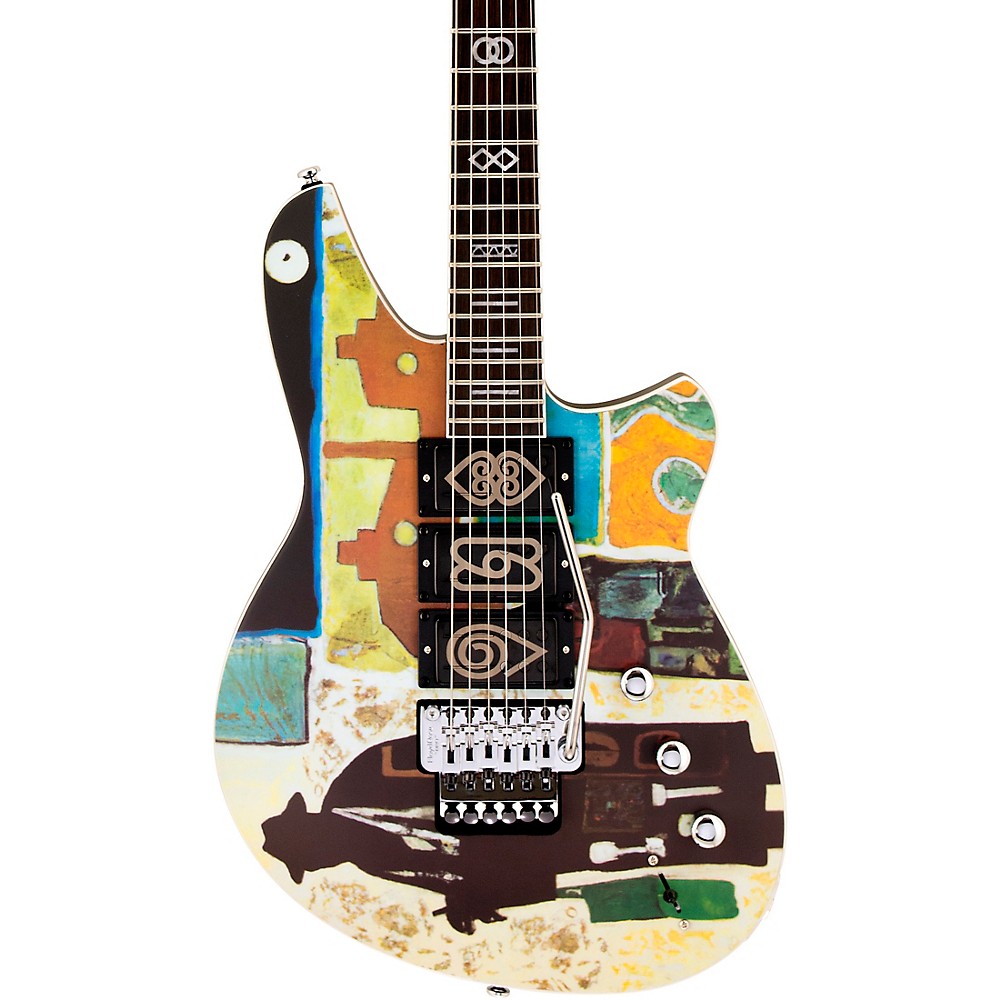
Reverend Vernon Reid Totem Electric Guitar Mystery Tramp
Martin Guitar Reissues the 00DB Jeff Tweedy and Introduces the 000 Jr E Jeff Tweedy
C. F. Martin & Co.® is proud to announce the return of a fan favorite and the launch of an exciting new model: the 00DB Jeff Tweedy and the all-new 000 Jr E Jeff Tweedy. Both signature guitars were designed in collaboration with GRAMMY® Award-winning artist, songwriter, and Wilco frontman Jeff Tweedy, whose influence as a songwriter has inspired generations of musicians.

The 00DB Jeff Tweedy, first introduced in 2012, quickly became a favorite among players for its warm, balanced voice and its pioneering use of FSC®-certified tonewoods. Today, the mahogany-bodied model returns with all the features that made it iconic: a deeper 00 body for added resonance, scalloped European spruce X-bracing, a long 25.4" scale for clarity and punch, and a striking custom Tweedy Burst finish. Updates include a certified ebony fingerboard and bridge, underscoring Martin’s and Jeff’s shared commitment to sustainability.
“The thing I love about my guitar, the deep-body element of it, is that it has a warmth for a smaller body guitar,” Jeff explains. “It’s somewhere between a Dreadnought and an 0-style guitar.”
Joining the Martin lineup for the first time is the 000 Jr E Jeff Tweedy, a signature model designed to be more compact and accessible while capturing the spirit of his 00DB. Crafted from FSC®-certified sapele with the custom satin Tweedy Burst finish, it features a 000 Junior body with a full 24.9" scale length, Martin E1 electronics with a built-in tuner, and a Performing Artist neck for easy playability.
“The idea that we could do this again, and then also offer a guitar that may be a little bit more affordable to people starting out, and maybe a little smaller for smaller hands starting out—that's a thrill to me,” says Jeff.
Both models trace their inspiration back to the vintage Martin 0-18 Jeff purchased in the late 1990s, the guitar he used to write the celebrated Mermaid Avenue album with Billy Bragg, setting Woody Guthrie’s unheard lyrics to music. That instrument, he says, “became basically part of my writing voice… it’s the main acoustic I’ve had my whole life.”
For Jeff, guitars have always been tools for expression and creativity—not status symbols. “Well-made guitars, like the Martin guitars that you make, inspire creativity because they don’t present an obstacle to creativity,” he says. “Someone buys a guitar with my name on it and takes it home—I hope it becomes a part of their daily habit of making some music.”
The 00DB Jeff Tweedy and 000 Jr E Jeff Tweedy are now available through authorized Martin dealers worldwide and martinguitar.com.
These Fender Japan x Godzilla guitars might be the coolest we’ve seen this year – and possibly ever

Fender Japan has unveiled three Godzilla-themed Stratocaster guitars, and one of them even roars with the push of a button.
The lineup has been launched in honour of Godzilla’s 70th anniversary, and consists of three models: a Limited Edition Masterbuilt Godzilla Stratocaster, crafted by Fender Custom Shop Master Builder Andy Hicks (with only units five available), plus two made-in-Japan models – the Godzilla Stratocaster Blue and Godzilla Stratocaster Black.
- READ MORE: Harness the raw tone of ‘50s tweed amps and the mid-’60s cleans with Fender’s new Super 62 combo
These guitars are seriously cool, with the Limited Edition model offering a unique button that plays out Godzilla’s famous roar, marking the first time a button like this has ever been incorporated into a Fender guitar. Hicks designed the model in collaboration with illustrator Tom Neely, and it was unveiled at a special event at Fender’s flagship Tokyo store.
Speaking to Guitar World, Neely explains of its design: “For the front of the guitar, we featured a black-and-white Godzilla with a blue blast to complement the neck inlay, capturing the spirit of the Heisei-era films. For the back, to celebrate Godzilla’s 70th anniversary, we created a montage of seven Godzillas – from the 1954 original to Godzilla Minus One – and added neon paint that glows under black light for a dynamic effect.”
Of course, the most important element of this guitar is its visual design, so its other features are fairly simple, including a single humbucker that is said to be a tweaked version of Hicks’ favoured Sonic Pickups Cult Leader, and a single volume control.
As for the made-in-Japan models, though they are both slightly less pricey, they are not without their flashy appointments. Godzilla is outlined on the pickguard on these models, and players can press the Tone 2 knob to engage a brand new and patent-pending circuit known as G.L.O, or Gain-Linked Optics. This magical onboard distortion circuit illuminates Godzilla’s dorsal fin, and its brightness changes in response to gain levels.
The Blue and Black models are exclusive to Japan, and are each fitted with a Custom Godzilla humbucker that promises a unique, heavy tone. They’re priced at ¥495,000 each (approx $3,250), while the Masterbuilt Strat is a whopping ¥5,500,000 ($36,000). But that’s not all, as a Godzilla-themed distortion pedal will also be made available exclusively in Japan.
Find out more via Fender Japan.
The post These Fender Japan x Godzilla guitars might be the coolest we’ve seen this year – and possibly ever appeared first on Guitar.com | All Things Guitar.
“I don’t subscribe to the idea that all vintage instruments are great”: Chris Buck on why cheap guitars can be just as effective as expensive ones

Does the fact a guitar is old and worn-in make it better? It’s a debate which continues to rage in the guitar community, particularly among lovers of vintage instruments.
While there are vintage guitar aficionados aplenty, many high-profile players tout the benefits of newer – and importantly, cheaper – instruments, and how they can often beat their vintage counterparts.
Take former Steely Dan guitarist Jeff “Skunk” Baxter, for example, who recently told the story of how he opted for a $140 Squier Telecaster over its 1958 vintage counterpart. “I compared the two, and the $140 Squier Telecaster, to me, sounded better,” he said.
Now, guitarist Chris Buck has added his voice to the same side of the debate, telling Guitar World in a new interview that older doesn’t always mean better.
“I don’t subscribe to the idea that all vintage instruments are great,” he explains, “because I’ve definitely played some dogs. Some of my favourite guitars were made after 2020, and some were made in the ‘60s.
“There’s a synergy between you and a great instrument. That could be a $300 Squier or a $5,000 Gibson. It doesn’t matter. If it speaks to you, it’s the one.”
Of course, Chris Buck isn’t saying cheaper guitars always outcompete their vintage counterparts, and has a lot of love for some of the many vintage six-strings he’s had across his lap in his time.
They include the late Bernie Marsden’s ‘59 Gibson Les Paul Standard Burst – “The Beast” – a ‘62 Strat which forms part of his own personal collection, and a ‘62 Gibson ES-335.
“The moment I strummed it, I thought, ‘This is alive,’” he explains, recounting the first time he played the ES-335.
“The guitar’s a mess, but I fell in love with it. It’s got original PAFs and original electronics. It’s been resprayed. The headstock has had a catastrophic break – but it’s just such an amazing instrument.”
The post “I don’t subscribe to the idea that all vintage instruments are great”: Chris Buck on why cheap guitars can be just as effective as expensive ones appeared first on Guitar.com | All Things Guitar.
Graham Nash dismisses talk that he might retire from music: “As long as my voice lasts, and so far it’s brilliant, I will be doing this into my 90s”

Graham Nash doesn’t plan to retire from music anytime soon, if ever, as he confirms that he’ll continue performing music for as long as he possibly can.
Nash, now in his eighties, is out on the road this October for his More Evenings of Songs and Stories tour across the UK and Europe. The shows do quite literally what is said on the tin – provide an evening of both music and the stories behind the songs that make up Nash’s long and successful career from across the decades.
In a new interview, Nash says he’s not planning to step down from the stage, just as long as he can keep attendees at his gigs happy. He tells Devon Live, “I just want the audience to be completely satisfied. The truth is, as long as my voice lasts, and so far it’s brilliant, I will be doing this into my 90s. There are a lot of people that want to hear it.”
Elsewhere in the interview, Nash also confirms that he’s recently been working his way through forgotten material, including unreleased Crosby, Stills, Nash & Young songs: “I’ve been involved in a lot of the stuff that me and David, Stephen, and Neil made that has never been heard before.”
According to the outlet, he’s been working on this material with Joel Bernstein, a guitar tech who’s worked for Neil Young and Prince. Nash adds, “He and I are putting together 33 songs of Crosby, Stills & Nash that have never been heard. I’ll maybe do them on the tour between those six or seven songs I know people want to hear.”
Tickets are still available for Graham Nash’s Songs and Stories tour – find out more via his official website.
The post Graham Nash dismisses talk that he might retire from music: “As long as my voice lasts, and so far it’s brilliant, I will be doing this into my 90s” appeared first on Guitar.com | All Things Guitar.
“It happens. Especially to those of us horrible drivers”: Gene Simmons recovering at home after Malibu car crash

Kiss’s Gene Simmons is reportedly recovering at home after being involved in a car crash in Malibu, California.
According to NBC 4 Los Angeles, the incident took place on Tuesday (7 October) around 1PM local time. The bassist has apparently told authorities that he had passed out while driving. Simmons’ wife Shannon Tweed added that the car passed through several lanes of traffic before crashing into a parked car.
Per reports, Simmons was briefly hospitalised, before being sent home to finish his recovery.
Following the accident, Simmons took to social media to reassure fans: “Thanks, everybody, for the kind wishes. I’m completely fine. I had a slight fender bender. It happens. Especially to those of us [who are] horrible drivers. And that’s me. All is well.”
Thanks, everybody, for the kind wishes. I’m completely fine. I had a slight fender bender. It happens. Especially to those of us were horrible drivers. And that’s me. All is well.
— Gene Simmons (@genesimmons) October 8, 2025
The 76 year old has had numerous health issues in recent years, including when he suffered dehydration during a Kiss show in Manaus, Brazil in 2023, causing the band to have to pause the show.
Simmons has also reportedly been suffering with a heart condition called atrial fibrillation (AFib) since the 2000s.
“I had never heard of the term AFib, but about 10 years ago, we were on tour someplace, and [on] stage the temperature goes up about a hundred, with all the stage lights and my heart [starts pounding really quickly],” he told The Doctors in a 2016 interview [via Blabbermouth].
“I started to get dizzy and perspire and [get] short of breath. So I called a doctor and he showed up and said, ‘Okay, here’s what’s going on. There’s something called AFib,’ and he went down the list. And it was a lot to take in.”
Kiss played their final show at Madison Square Garden in 2023, and announced the band would live on as digital avatars, with Las Vegas shows due to start in 2027.
The post “It happens. Especially to those of us horrible drivers”: Gene Simmons recovering at home after Malibu car crash appeared first on Guitar.com | All Things Guitar.
How to get better Google Search results: add Guitar.com as a Preferred Source on Google

Have you been browsing your search results of late and wishing they could be a little bit more, well, guitar-y? Well, thanks to a new feature introduced by Google, you can now ensure that Google knows that Guitar.com is your top source for all the latest guitar news, reviews and features.
Available currently only to US- and India-based users, the new Preferred Sources feature lets you tailor your top news stories on Google based on your favourite media outlets – and you can do it in just a few clicks.
By adding Guitar.com to your Preferred Sources, you’ll be kept up to date with all the most important news from the guitar world, as well as our trusted expert reviews, in-depth artist interviews, and handy buyer’s guides. You won’t miss a thing, we’ll have you covered.
If you’re in the US or India, adding Guitar.com to your Preferred Sources is as simple as just clicking on this link right here, and ticking the box next to ‘Guitar.com’ – easy!
 Image: Guitar.com
Image: Guitar.com
Alternatively, you can also do this directly from the Google homepage by following these simple steps:
- Visit the Google homepage and search for any news story
- Hit the icon next to ‘Top Stories’ that looks like a box with a star in it
- Type ‘Guitar.com’ in the search box that then appears
- When you see Guitar.com show up, check the box to the right
- Hit the ‘reload results’ button and enjoy more Guitar.com in your searching!
 Image: Guitar.com
Image: Guitar.com
You can add as many other sources as you like, and can remove them at any time via the same method – though why you’d ever want less of Guitar.com in your life we simply cannot imagine.
And rest assured that you won’t only see Guitar.com news in your search results from then on – you’ll still get results from a variety of sources, this is just your way of telling Google that you like what we do and you want to see more of it when it’s appropriate.
As Google itself said in a statement: “When you select your preferred sources, you’ll start to see more of their articles prominently displayed within Top Stories, when those sources have published fresh and relevant content for your search.”
 Image: Guitar.com
Image: Guitar.com
In practice, that means Guitar.com will appear more frequently in the “Top stories” and “From your sources” sections on Google – and what a lovely idea that is.
If you’re not in the US or India, don’t fret – Google is planning to roll this out to other countries in the coming months, so keep an eye out for it. In the meantime you can ensure more Guitar.com in your news feed by following us on Google News – simply click this link and then hit the ‘Follow’ button on the top right.
The post How to get better Google Search results: add Guitar.com as a Preferred Source on Google appeared first on Guitar.com | All Things Guitar.
“You ain’t gonna hear nothing”: Buddy Guy admits that when he first saw Jimi Hendrix play live he thought he was “too loud” – but the Brits were next level

While the British Invasion saw the arrival of The Beatles, The Rolling Stones and The Kinks to American shores, it also forced the US to crank up the volume – and Blues legend Buddy Guy didn’t take too kindly to it.
In the latest issue of Guitar World, Guy notes that he even considered Jimi Hendrix too loud prior to the British takeover. “You’ll laugh, but I thought he used to play too loud…” he jokes. “But when the British guys started playing, they had stacks of Marshalls!”
Guy goes on to admit he used to leave early Hendrix gigs with sore ears, but the Brits were next level. The spike in volume was a shock for the old-school blues star. “When I first came up, Muddy Waters and those guys had two little speakers at each corner of the blues club, and it was a clean sound,” he recalls.
After forming a bond with Hendrix, Guy would even joke about the loutish punch of noise the Brits had to offer. “After I got to know Jimi, I’d go see him and say, ‘Before you go in there, you ain’t gonna hear nothing,’” he says. “That type of sound just took over.”
“That clean sound went away because, with the amplifiers, it was a dogfight,” he continues. “It was just a rat race. And then all the special effects came in, and Jimi, I think he was one of the greatest that ever took advantage of the special effects, because a lot of people used them after him.”
However, regardless of how loud the British guitarists may have sounded, Guy notes that they could never quite replicate the intricacy of his own introspective, more quiet tone. “All the super British guitar players, like Jeff Beck and Jimmy Page… they all looked at me and said ‘Man, I didn’t know that kind of guitar could play the blues,’” he remembers.
“The British guys all say I had something,” he adds. “People used to look at me and ask what [guitar] I had. I’d say ‘I didn’t make it, Leo Fender made it. It’s just a tone.’ That tone is so clear, and I never really paid attention to it. I just turn on the amplifier and play my guitar.”
The post “You ain’t gonna hear nothing”: Buddy Guy admits that when he first saw Jimi Hendrix play live he thought he was “too loud” – but the Brits were next level appeared first on Guitar.com | All Things Guitar.
Mystifying riffs, not knowing your own songs and pining for Fiesta Red Strats: inside the chaotic brilliance of Militarie Gun

If you ever find yourself in a room with Militarie Gun, brace yourself for impact. Weaned on the blood, sweat and tears of the American punk scene, the hardcore ethos of visceral, in-your-face catharsis is rooted in the band’s genetic code. Throughout every vulnerable acoustic number, synth-heavy anthem and soaring alt-rock riff, the magic of Militarie Gun lies in that heart-on-sleeve hardcore authenticity.
Even today, the raucous quintet are gearing up to play to 50 people in a venue the size of a living room – the prime setting for a sweaty punk show. Just days ago, they also performed in the tiny Hazheart storefront in Los Angeles. If size matters, the smaller the better; a sweaty, intimate venue is where Militarie Gun thrive in, utterly befitting of their face-kicking, gut-wrenching flavour of alt-rock. “The Hazheart show was crazy,” guitarist Kevin Kiley grins. “There were some technical difficulties, because there was nowhere to stand but on top of my pedalboard.”
The slew of tiny shows are the perfect way to amp up excitement for the band’s sophomore release, God Save The Gun. And the response so far has been electric – Kick’s hilarious wails of “If I kicked you in the face, I’m sorry…” have been lapped up, while the rabble-rousing B A D I D E A has quickly become a new favourite, earning itself two spots on the setlist to close off on a chaotic high. The record amplifies Militarie Gun’s visceral alt-rock bite, both sonically and lyrically; not only does it see frontman Ian Shelton baring his soul, opening with a pained admission that “honestly, things have not been great”, but the instrumental carnage is second-to-none.
Heart Ripper
So how does one piece together a riff that rips your heart out, all before unleashing a string of chords that make your blood pressure spike? Well, according to long-standing guitarist William Acuña, ignorance is bliss. “I don’t know how to play guitar,” he shrugs, nonchalant as ever.
We pause, waiting for the punchline, but Acuña doubles down. “I mean, I know scales and stuff, and I can figure out what sounds good,” he continues. “But I don’t know any songs… I probably don’t even know every Militarie Gun song.”
In a way, the approach yet again falls in line with the hardcore, DIY roots of the project. Acuña’s self-taught approach is homegrown, resulting in a style that relies on pure emotion, instinct and a sound that is uniquely his own. “There’s all types of guitarists or songwriters that have talked about not wanting to ‘learn music’ because they don’t want to fuck up what they’ve got going for them,” he explains. “It’s the same with piano. I can play piano, but I also don’t know a single song.”
As his guitar comrade Kiley backs his claims up (“I’ve heard it, his piano sounds great!”), the pair point to one of the finest drummers of all time: The Who’s Keith Moon. “He was self-taught but he sounded incredible,” Kiley notes. “Most good drummers are people who approach a drum set as a kid and they just had a natural rhythm. And that can often be the same with guitarists.”
Of course, musical literacy isn’t a necessity to carve out a solid sound. “A good riff is catchy, it gets stuck in your head, and it works with the vocal melody,” Acuña says. “And I love a riff with a bend in it… but, yeah, we pretty much nailed all the riffs on this record.”
“What makes a good riff is so mystifying,” Kiley chimes in. “It doesn’t really matter how ‘good’ you are at guitar. It just comes to you, you can’t really plan it out…”
 Image: Nolan Knight
Image: Nolan Knight
Extra Levels
Having joined just last year, Kiley’s involvement in the band has added an extra level of guitar literacy to the project; “I feel like I am a pretty fluent guitar player,” he laughs. However, Kiley’s initial interest in Militarie Gun was rooted in the band’s overly ambitious, near-impossible riffs. “Before being in the band, I heard the Ain’t No Flowers lead riff and loved how stupid it sounded – and I mean that in the very best way,” he says. “It had that wild feeling that a lot of 80s punk stuff had – you could tell it was kids just getting all their feelings out there, learning as they went along.”
It’s a sentiment that doesn’t insult Acuña, who has served as the band’s rhythm guitarist from day one. “The way we play Militarie Gun songs can sound pretty fucked up because some tracks are written by someone who doesn’t play guitar all that great,” he admits. “I love when Ian writes a riff, because it’s written to convey an emotion, then we have to work out how to play it.”
“With Ain’t No Flowers, I used to stretch my fingers across the neck because there are the near-impossible notes that Ian wrote,” he explains. “Then Kevin came along, and he plays it completely differently because he knows an easier way to do it.”
Keep It Simple
While Militarie Gun may be overly ambitious with some of their riffs, their rig set up is pretty minimal. “A Strat, a RAT and a Twin Reverb,” Acuña lists. “That’s it.”
Even when digging into dream gear, both Acuña and Kiley are reserved with their choices. Militarie Gun were named one of Fender’s Next Class bands of 2024, and they’re more than happy to keep waving the flag for the humble Strat. “I just enjoy a Strat, because it’s light and easy to play,” Acuña shrugs. “For me, it’s always about how it feels to play, how the neck feels, because the sound all goes through a RAT distortion pedal anyway.”
There’s also the worry about durability when you’re known to have particularly chaotic shows. “A Strat is also very sturdy, so you don’t have to worry about the neck snapping or the headstock cracking,” Acuña notes.
“I also prefer a Strat – I’ve played a Strat my whole life,” Kiley says. “In the studio I’ll use a Gibson for leads; I have this Gibson with a certain humbucker on it, and it sounds huge. But, when it comes to a live show, nothing stays in tune as well as my Strat. It’s just reliable.”
With the addition of Kiley’s “fluent” guitar knowledge and a thirst for experimentation, God Save The Gun pushes Militarie Gun’s sound into an entirely new realm. Cuts like Maybe I’ll Burn My Life Down serves up a bold new way of capturing a gritty electric tone, utilising blown-out acoustic in lieu of standard electric guitar. “We played so much acoustic with blown out distortion, so you’d think it was an electric,” he explains. “That track is entirely acoustic guitar.”
“The last song, God Save The Gun, has a lot of blown out acoustic but we did put some electric in there,” he adds. “But originally, the demo was just distorted as fuck acoustic with a tremolo over it.”
 Image: Nolan Knight
Image: Nolan Knight
Mello Yellow
Sonically, the record is bursting with unique textures. “With God Owes Me Money, the demo was all synths,” Kiley explains. “I wondered if it would become a guitar lead, but nothing sounded as good as the synths on there. It felt right. We don’t shy away from anything, because we never want to put ourselves in a box. If the song would be bigger and benefit from synths, then we do it. If it’s keys, strings… even Mellotron! We used Mellotron all over the record.”
Every sonic decision serves as a way of hammering home Shelton’s candid lyrical journey. “We always let Shelton tell his story,” Kiley says. “The entire tracklist is very intentional; it goes on a journey and it gets pretty deep, dark and poignant. A few people contacted Ian asking if he was okay after listening through the record, actually. But there’s an arc to it…”
Emotionally, I Won’t Murder Your Friend comes in as one of the most powerful of the bunch. It features a sample of David Choe mourning the loss of Anthony Bourdain, who committed suicide in 2018. “We were really throwing everything at the end of that song,” Kiley explains. “Lyrically, I think it is the heaviest on the record.”
 Image: Nolan Knight
Image: Nolan Knight
Slap Back
After an onslaught of introspection, the pivotal point of God Save The Gun comes in the form of an interlude featuring Isaac Brock of Modest Mouse. “Isaac’s Song is one of my favourite moments on the record,” Kiley explains. “Ian keeps describing the track as a moment where Isaac kind of ‘picks you up, dusts you off and tells you it’s going to be okay’. He just picks you up, slaps you around.”
Acuña quickly pipes up, lightening the mood: “He actually did slap me, once. We were getting really drunk at his studio and I was falling asleep, and he just slapped me to wake me up. He felt bad about it, so he had me slap him, but I slapped him too hard for his liking, so he slapped me again, and then I slapped him back. And then we just started dancing. It’s an honour to be slapped by your musical idol.”
While Kiley has only joined the ranks recently, his history runs pretty parallel to Militarie Gun; his previous band, Lurk, even supported Militarie Gun on their first ever tour. “The first time I met these guys, my band was playing with them in smaller venues, like downstairs in Subterranean in Chicago,” Kiley reminisces. “It was so small all the gear had to go in the kitchen.”
Since joining, he’s been thrown in the deep end. Militarie Gun has become somewhat of a behemoth as of late, falling in line with the recent spike in popularity that Californian punk and alt-rock has mustered. “My first show with the band was at the Daytona Speedway for Welcome To Rockville festival last year,” he explains. “I’ve played in bands my whole life, and that was the biggest show I’ve ever played to date. It was kind of crazy to go from basements to that.”
So, what do the pair of guitarists want from God Save The Gun? “I want a Fiesta Red Strat with a Fiesta Red headstock,” Acuña states, deadly serious. “That’s the Will Acuña Custom Fender, when they’re ready.”
They also hope that Killing Joke like the sample they used on the “apologetic stage-diving” tune Kick. “They approved it, but they didn’t say a word about it,” Kiley admits. “But I guess, if they don’t, it’s their own fault for saying yes…”
The post Mystifying riffs, not knowing your own songs and pining for Fiesta Red Strats: inside the chaotic brilliance of Militarie Gun appeared first on Guitar.com | All Things Guitar.
Stompboxtober 2025: Radial Engineering

Today’s Stompboxtober prize is the powerhouse Radial Twin‑City amp switcher — route your guitar to two amps (or toggle between them) cleanly, noiselessly, and in phase. Enter now for your shot to win today’s gear, then keep coming back all month for new pedal giveaways!
Stompboxtober 2025 - Win Pedals All Month Long!
Twin-CityActive Amp Switcher
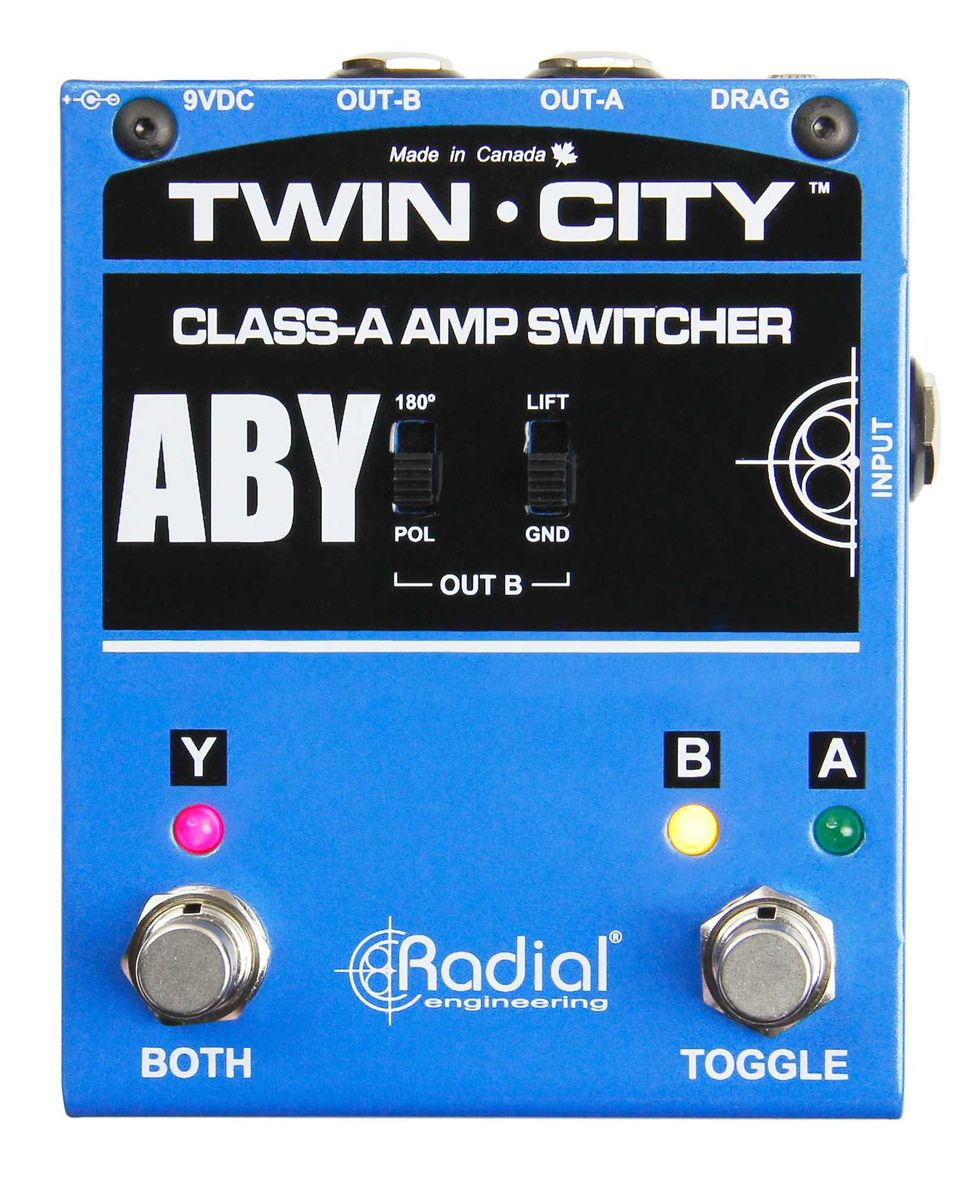
The Twin-City is an active amp selector that lets you connect any two guitar amps and switch between them or drive them both simultaneously without noise, loss of gain, or any degradation to your natural guitar tone.

Radial Twin-City ABY Amp Switcher Pedal
Joe Bonamassa’s legendary 1959 “Black Beauty” Les Paul Custom is now available as a sub-$1,000 Epiphone model

Joe Bonamassa’s gear collection is quite something; it even warrants two museum locations – Nerdville East and West – in Nashville and Los Angeles, respectively.
One highlight of his collection – of which there are obviously many – is his 1959 Gibson “Black Beauty” Les Paul Custom. As the story goes, the guitar is one of only a “handful” made – “maybe 20 or less in existence,” Bonamassa says.
“My one came from a little old lady in Pennsylvania,” he says. “The family didn’t realise it was a very special, rare variant.”
JoBo’s “Black Beauty” Les Paul Custom was rare at the time of production for its two-humbucker configuration and Bigsby vibrato, and now it’s been recreated as an Epiphone signature model.
Designed to be “both faithful and accessible”, the Epiphone Joe Bonamassa ‘59 Les Paul Custom sports a solid mahogany body with an Antique Ebony finish, accented by aged multi-ply binding on the top and back.
Its mahogany neck features a 1959 Rounded Medium C profile, and is topped with a bound 22-fret ebony fingerboard and pearloid block inlays.
Elsewhere, the guitar features a multi-ply bound ‘60s Kalamazoo-style headstock with the Epiphone logo and the classic Custom Split Diamond inlay in mother-of-pearl, while there’s also a low-friction Graph Tech nut for tuning stability.
True to the Black Beauty, the Epiphone recreation also features a Bigsby tailpiece. The run of 1959 Gibson Les Paul Customs featured some with Bigsbys and some with Stop Bar tailpieces.
“Bigsbys are great because they have their own unique sound. They’re not like Floyd Roses or Fender trems,” Bonamassa says. “They’re a little brighter; it’s a little more hi-fi, but it will rock.”
The guitar also boasts Grover Imperial tuners – the same that decorate JoBo’s original Black Beauty Les Paul. “The Grover Imperial tuners came stock on my guitar, so they come stock on yours as well,” he explains. “So it gives it a fancier look.”
 Credit: Epiphone
Credit: Epiphone
In terms of electronics, the Joe Bonamassa ‘59 Les Paul Custom features a pair of Epiphone ProBucker Custom pickups, wired to individual volume and tone controls using high-quality CTS potentiometers for “outstanding tonal versatility and reliability”.
Completing the faithful look is a run of gold hardware, including the guitar’s Tune-O-Matic bridge, Grover tuners and Bigsby B70 tailpiece.
Each Joe Bonamassa ‘59 Les Paul Custom comes with both a certificate of authenticity and a hardshell case with “Nerdville” graphics.
The guitar is limited in an initial run to 1,000 units – available via Epiphone, the Gibson Garage and authorised Epiphone dealers. A run of 300 with an exclusive custom fretboard inlay will also be available via Joe Bonamassa’s webstore.
The Joe Bonamassa ‘59 Les Paul Custom is priced at £949 / $999. For more info, head to Epiphone.
The post Joe Bonamassa’s legendary 1959 “Black Beauty” Les Paul Custom is now available as a sub-$1,000 Epiphone model appeared first on Guitar.com | All Things Guitar.

